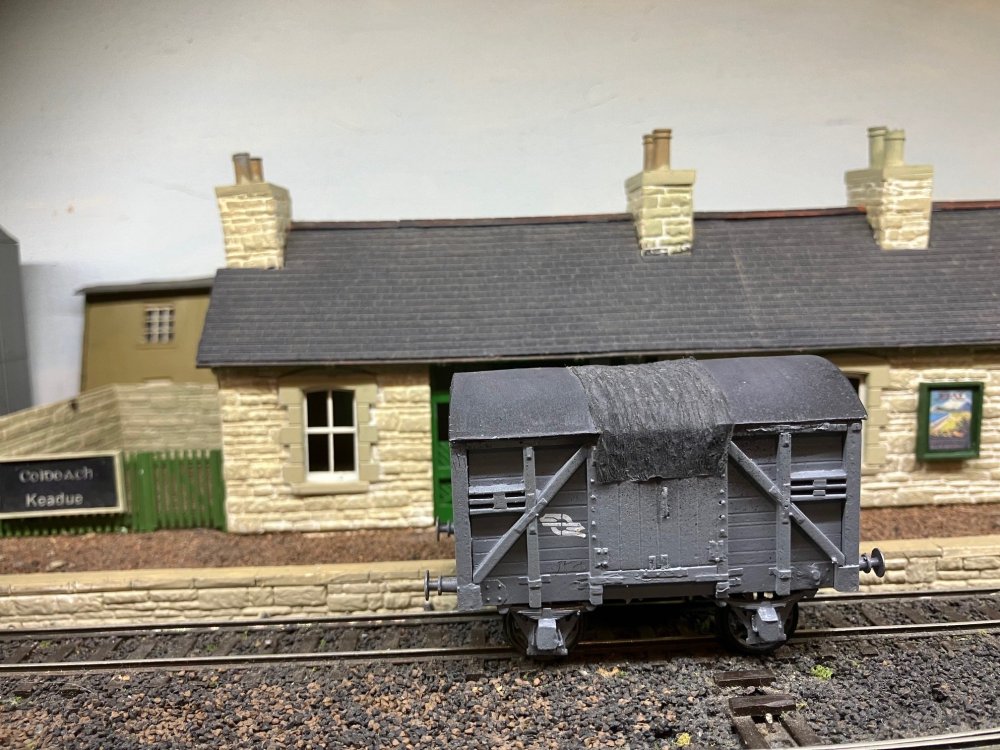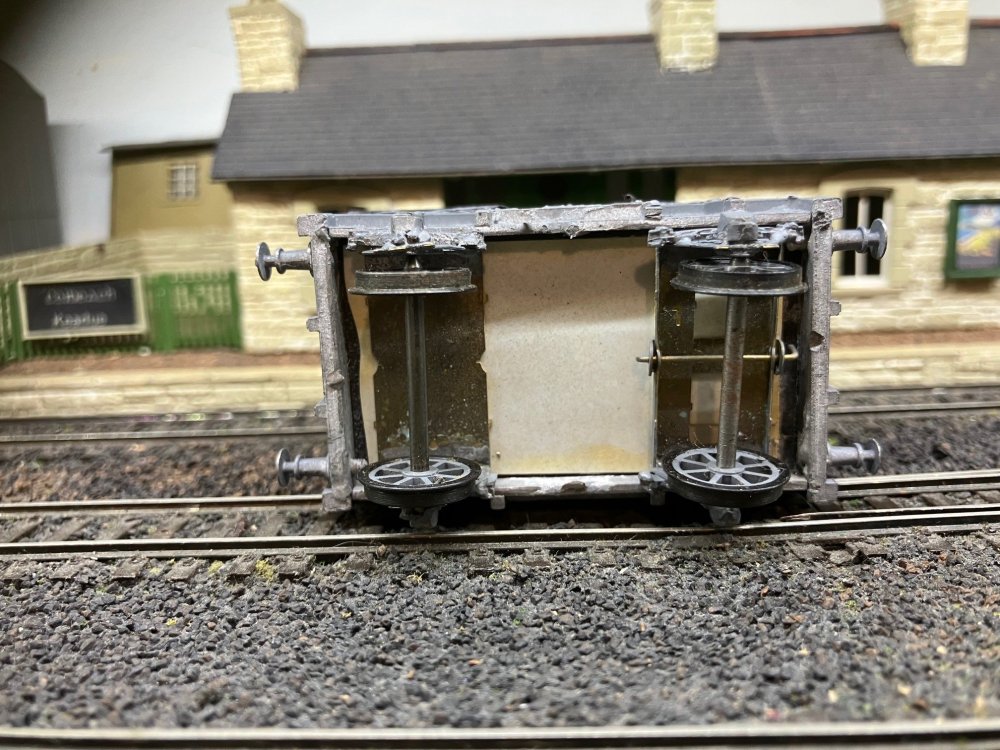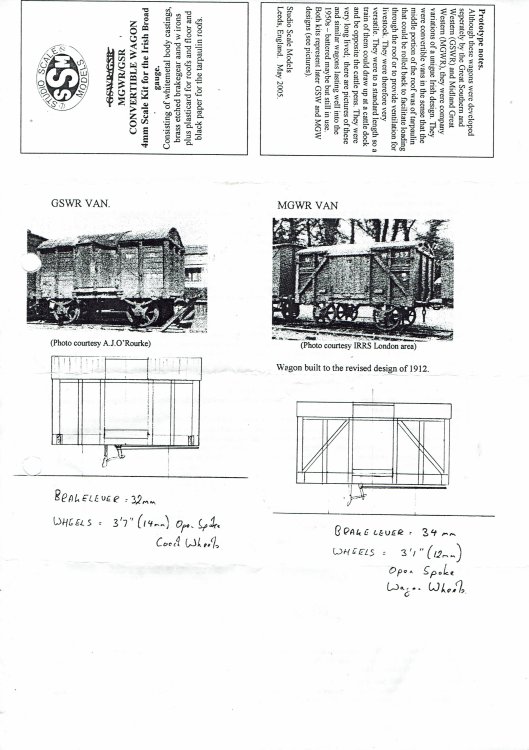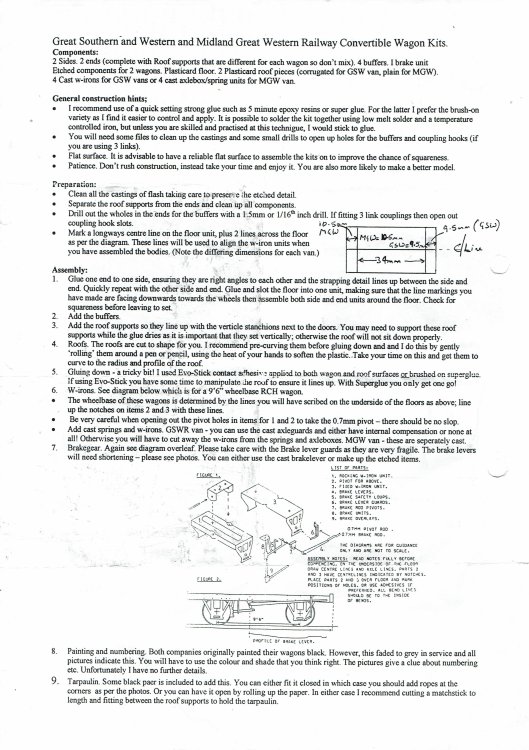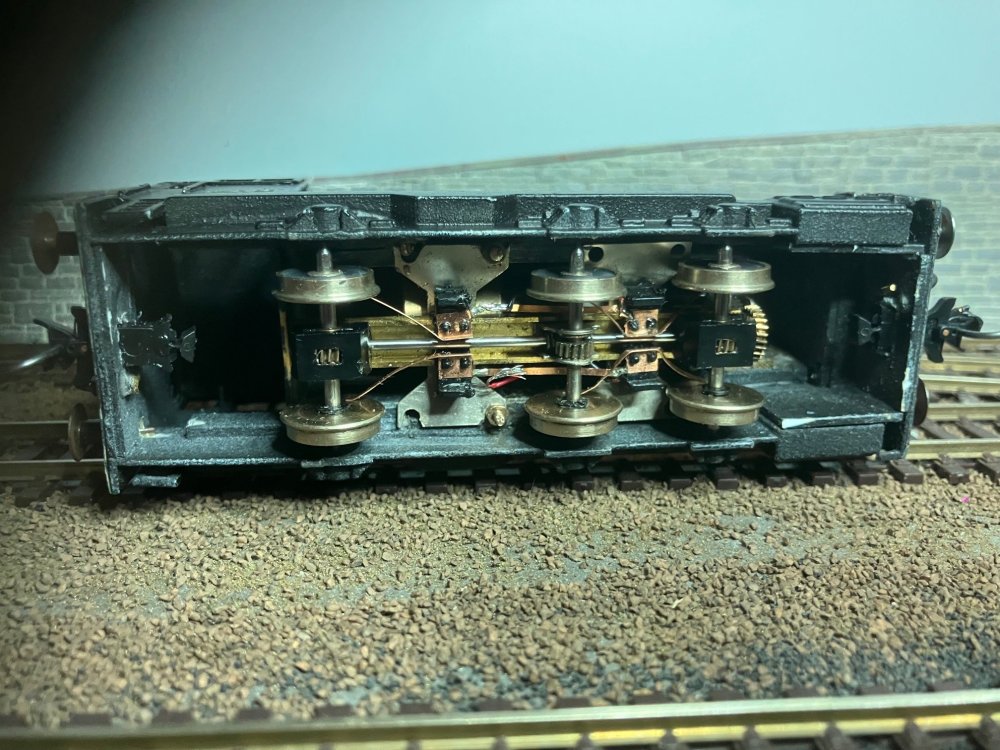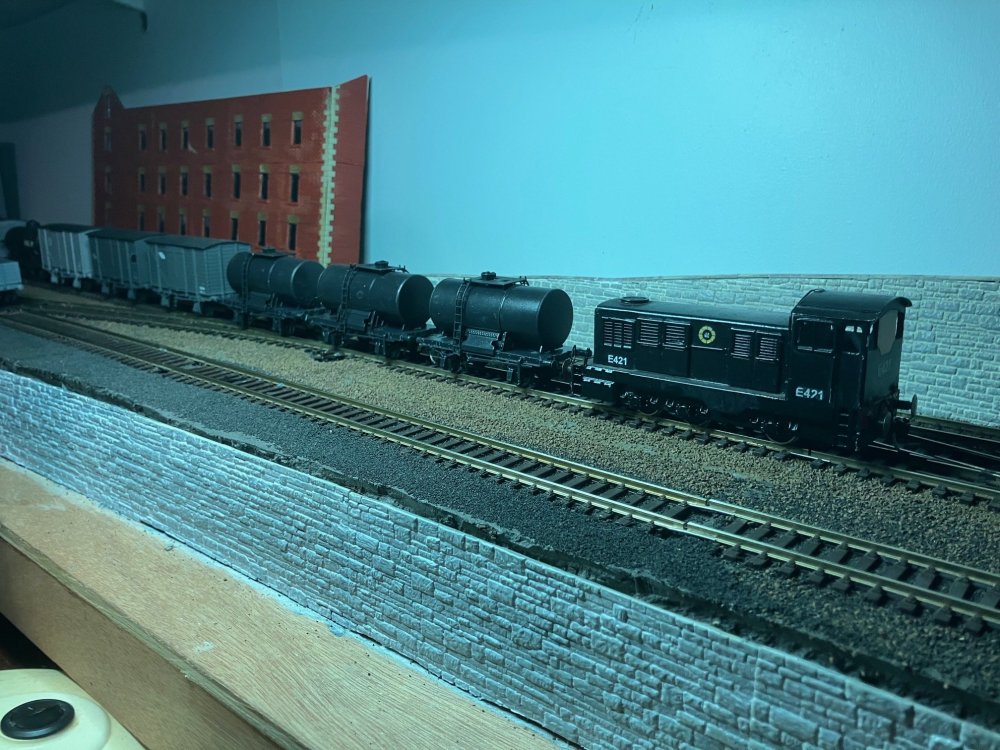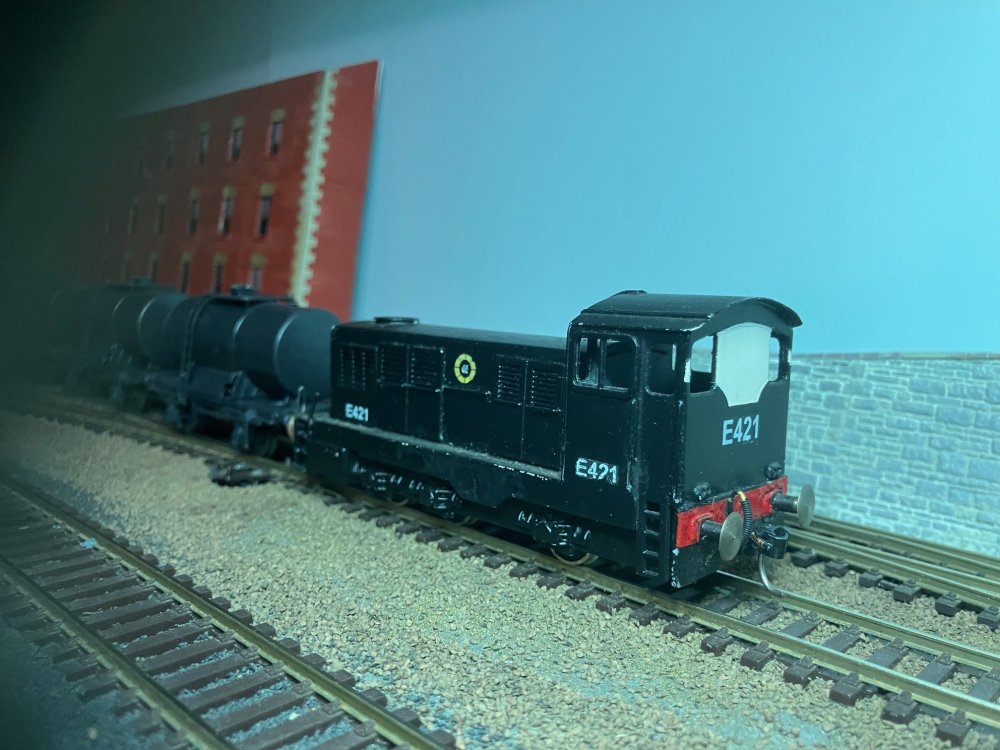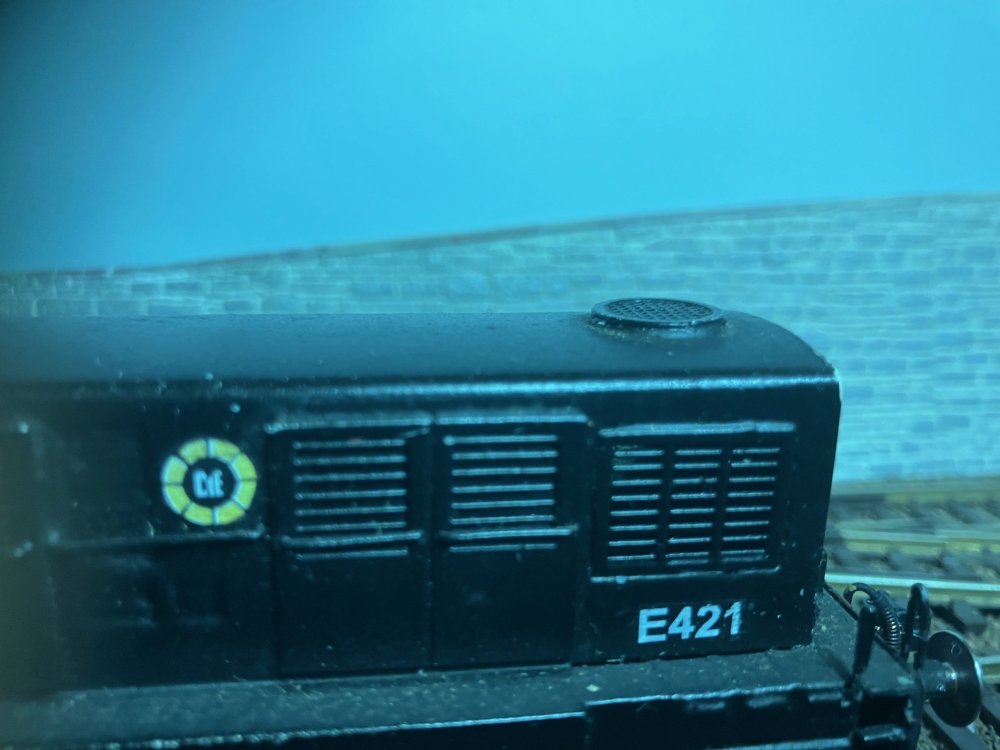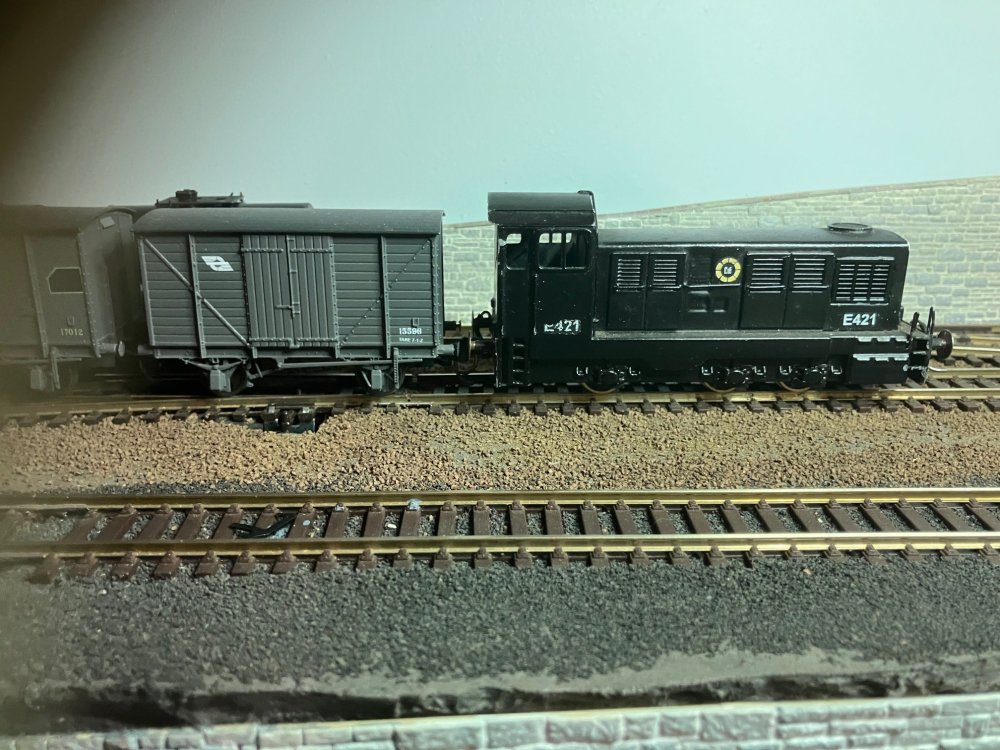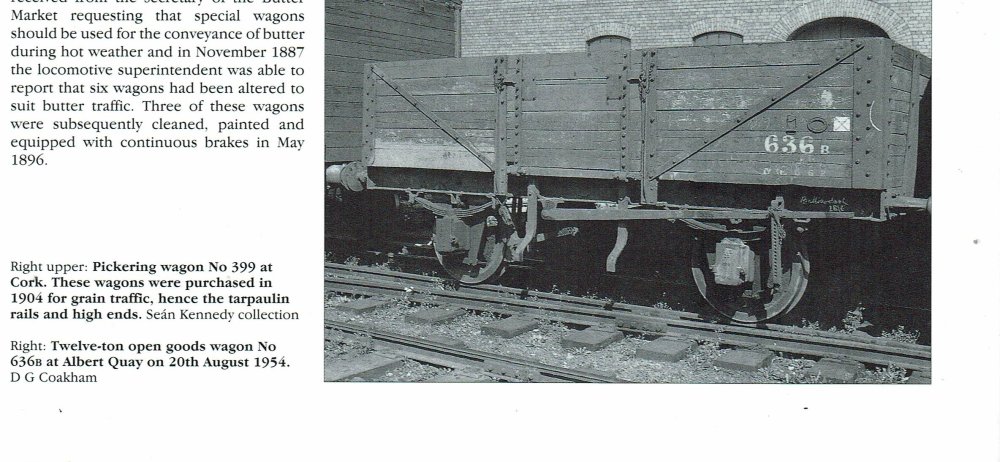-
Posts
4,863 -
Joined
-
Last visited
-
Days Won
119
Content Type
Profiles
Forums
Events
Gallery
Blogs
Store
Community Map
Everything posted by Mayner
-
I remember reading somewhere that the West Cork railcar set was serviced weekly (at Cork) and a steam working substituted on the day (a GSWR 2-4-2T?) Its possible that railcar maintenance was centralised at Inchacore? as sufficient railcars became available to work all regular diagrams, in a similar manner to the way the Cobh 2600 set was swapped around on Sundays using a return Cork main line working. There was some odd C Class diagramming for maintenance rotation purposes on the West Cork system, the one of the Up goods trains was apparently scheduled to swap locos at Clonakilty Junction with the loco of the Up Branch train. The loco off the Up goods presumably working the Branch for several days while the Branch loco continued to Cork for service/maintenance. Presumably swapping the loco of the goods with the Branch train avoided a light engine movement from Cork to Clonakilty Jnt With the C Class reputation of poor reliability its possible that a lot of swapping about was required to keep sufficient locos in operation to operate the two daily goods trains & the Baltimore and Clonakilty mixed. Dan Renehan in his article on the Metrovick diesels in the IRRS Journal wrote about the amount of 'swapping' around that was necessary to operate the schedule using the A Class diesels, main line passenger and goods workings were diagrammed to the locos in the best mechanical condition and lubricating oil regularly monitored to assess condition and locos rotated to less ardous passenger and finally goods workings as the condition of the lubricant deteriorated. He wrote of fitters travelling in the engine compartment of A Class on Knock Specials attending to leaks and faults as they developed while the train was running. There was a story of Radio Technicians boarding a loco in white overalls which quickly turned grey while trialling radio telephones on the A Class during the 60
-
Being young and ambitious I was recruited a couple of times in the late 80s into DOGE style management teams on London area construction projects that were in or getting into trouble. (Usually over budget, behind schedule and sometimes serious quality problems. Interestingly the recruiter and interviewers kept very quiet about the trouble shooting nature of the role or being recruited into a new team to replace existing staff. The first on a major Wapping residential development (opposite the Prospect of Whitby) by an old established Building Company from the South Coast was one of my most enjoyable and frustrating roles in 30 years working in construction. I was hired by the London director (a GWR enthusiast) and got on well with my Boss a Londoner of Scottish extraction who was brought in to turn the project round and the Commercial Manager (Snr Quantity Surveyor) going out for a meal and drinks on Thursday evenings, the job paid well with salary review and pay increase almost every time the deputy GM visited London, the car was the best perk the company ran its own fleet and I got the Managing Director's David cars (a Ford enthusiast) as he traded up starting with an Escort XR3 and later a Sierra Saphire (XR4) pretty good with unrestricted private use holidays and weekends. The frustrating bit wasn't that the project had fallen behind schedule, over budget and there were serious quality problems/repetitive errors, but there were serious problems at Head Office level that the Trouble Shooter, Peter (a Scott) brought in to re-organise the company was unable to influence. The business was basically a family firm controlled by three brothers divided into a Building Division (income from external clients) run by the MD, with a Plant Hire division (Brother 2) and Joinery Divisions (Brother 3) as preferred suppliers to the Building Division. Dealing with the Plant Hire division was almost Dickensian there was a minimum 2 week lead time on all orders regardless of urgency (fax & paper original) anything from a small power tool to a Site Office faxed & internal mail to the South Coast although often cross-hired from a Docklands Plant yard. The last straw for the Commercial Manager was when the Plant Division supplied some WW1 or possibly Crimean War huts as office accommodation for our Client and then got into trouble for ordering some modern Portacabins. My last straw when finally given 'my own" project a project for a Hackney Housing Association that was at an advanced stage of construction (beautiful Facade tiny apartments/town houses, was to find that I had 20 almost complete two storey town houses with no staircases, the Joinery Division were unable to provide a projected delivery date. Peter (the Troubleshooter) and I resigned around the same time. Peter had to go as the MD David was not prepared to have the hard words with his brothers, the Brothers eventually managed to sell the business which ceased trading after 2000, though its now almost 40 years since I worked at Shadwell Basin. The next job was with a building company that pioneered "Fee Contracting" in the retail sector which morphed into a form of Partnership Contracting for major commercial and retail projects in the 1990s and again found myself recruited into a new management team on a major retail project in Watford. After the nice pleasant interview and induction & given a company car at Head Office, my first inkling that something was amiss was when I was greeted with 'who the fuck are you" when I reported to the "Site Superintendant" on my first day on site. I was quickly taken under the wing of Tony the Superintendant (company tended to use different job descriptions for the same job to most other UK contractors) on Phase 2 of the project which was complex and kept me busy for about 4 years. During the re-organisation the company dropped all reference to "Site" and usual industry roles from its job descriptions A Site Manager became a Construction Manager, a Quantity Surveyor a Commercial Manager. Although originally pioneering the organisation became outdated and complacent and was not up to managing the large complex projects that emerged in the "Big Bang" era, the entire senior management team (above line manager) on the project was replaced during my first year on site, some of the senior management people did not realise what was happening until they received their severence. In certain respects the old school of senior management was more line Grace Brothers than what you'd expect on a then £100m project. David the "Superintendant" that greeted me on site had a site clerk more a military "Batman" Tom to keep the office organised, both were Scot's received lodgings and travelled home once monthly. Tom assumed that my overcoat was 'company issue" and asked me to sign a chit for my own coat. Tony's and my Senior Manager seldom if ever appeared on site (Project Office) had to be specially summoned to the Project Office to return his company car & receive his severance pay. Project was great fun for me identifying and offering solutions to problems, in one case we had to install a 12m temporary bridge to cross a basement excavation, after the local council a project client would not allow concrete trucks to cross a bus lane, in another the Clients Project Manager was not exactly pleased that I identified design issues that added £100k to the project cost. Client had imposed a 'design freeze" on the project before the completion of the architectural and engineering design was complete omitting a series of 'plant room" doors. Like the little boy pointing out that the King was wearing no clothes, I asked the Project Architect why there were no door openings or doors to a large no-of rooms and he was unable to answer. We had a good social life for several years on the project once the new management team settled down, though they increasingly became leaving does as the project would down with little emerging work in the pipeline I had that meeting with HR with generous redundancy terms and I got to keep my company car.
-
Thanks everyone for their support during the last week, my kid seems to be determined to keep me on the straight and narrow, and make sure I don't over-do things.
-
Interesting the Tralee & Dingle acquired a bogie van from the "Tubular Frame Wagon Co" in 1892 the long horizontal framing member looks tubular in section in the Alamy photo where you would usually expect to see a steel channel or rectangular section solebar. The underframe bracing and archbar trucks (bogies) appear very light in section for a goods wagon. There is a photo and a drawing of the T&D Tubular Frame Bogie Van No40(t) in David Rowand's Tralee & Dingle album (Bradford Barton 1977) Perhaps a sales rep trying to sell 'modern' high capacity wagons visited Tralee around the same time as the Harbor Commissioners fell out with the W&L. Some railway companies including the BNCR experimented with 'high capacity" wagons around the turn of the Century and wagon builders like Lancashire C&W would have been building high capacity wagons for the 'Colonies" The Lancashire wagon is quite different from American practice where Gondola's steel or timber framed usually have fixed sides and ends
-
Original Tralee & Fenit Harbor Commissioners loco which may not have passed to the GSWR. Recall seeing a photo somewhere an 0-6-0WT with outside cylinders and outside Stephensons valve gear
-
Featured on TV this evening the clip included a railway wagon, derlict Stockyard (Cattle market) public toilet complete with authentically modelled grafitti. Some mind blowing building and structure modelling (warts and all) buildings lost in 2011 earthquake by Mike Beer. https://www.artscentre.org.nz/whats-on/ghosts-on-every-corner/ https://www.instagram.com/ghostcat_mb/reel/DHXg5_CS5D2/
-
- 2
-

-
Can't hold a drill steady myself but a slitting disc in a Dremel seems to have been the preferred cutting tool of the guy that scratchbuilt many of the locos on the OO9 County Gate layout. Scratchbuit OO9 locos were watchmaking compared to OO or the so-called finer scales.
-
Here is one I assembled earlier (years ago!) & a set of instructions. Mixture of whitemetal castings, plasticard and brass w-Irons. The instructions recommends quick setting glue such as 5minute epoxy or superglue. Challenging bit may be sourcing suitable axles as the W Irons are designed for 21mm gauge which uses an axle that 2mm longer than standard for OO gauge, though I can sort you out with suitable wheels and axles if you decide to go ahead. The brass W Iron arrangement with one axle rocking (compensated) was a fairly common arrangement with scratch and kit built wagon. I generally solder whitemetal kits using a special 'temperature controlled" soldering iron (expensive) with 100º solder & phosphoric acid flux not really practical or wroth while for assembling one kit. Age experience and skill. I first tried my hand at scratchbuilding using plasticard when I was around 14-15 and later moved on to tin scrounged from food tins, usually on second hand Triang chassis none of these early efforts were exactly successful. I started my first reasonably successful efforts at model making in my late teens after I began working after finishing secondary school including a reasonably successful "Irish' N gauge layout before returning to 4mm and attempting to model in 21mm gauge in my Mid-20s. I assembled my first Etched Brass loco kit a TMD/SSM Midland Tank in the Mid-80s but it took me approx 8 years to become reasonably proficient in kit/scratch building. Like training for a profession or "serving your time" as a trade its takes time to become reasonably proficient in model making.
-
Well my plans to set out some modelling time daily came unstuck when I collapsed at home on Friday was admitted to Emergency and ended up spending 24 hrs under observation in hospital. Luckily my 15 year old who is suffers with anxiety stayed calm gave first aid, called the ambulance and accompanied me to hospital, Luckily they found nothing life threatening, most likely cause was a sudden loss of blood pressure possibly de-hydration or stress. Our family have been in a difficult position for the past 18 months split between the United States where my wife has been caring for her elderly father while I care for our 15 year old who has mental health problems and my elderly mother in law. Strangely we though we had got through the worst of it, my father in-law (a great guy) recently peacefully passed away and our 15 year old had begun showing signs of improvement before we experienced a series of setbacks during the past four weeks. I suppose my collapse was a warning sign for me that I am not invincible and to slow down or I may not be around for my family or to play trains, The irony is I have been down this way in my working life 3 times over the past 20 years and still think I am invincible and can keep everything under control. Wife Linda hopes to return during the next 6-8 weeks which should spread the load in caring for our child and supporting Linda's mum, in the mean time I need just to do the bear essential at home. I did manage to sneak into the workshop last night and complete some adjustments on E421, which now runs more reliably though still occasionally de-rails on Peco small radius points.
- 392 replies
-
- 17
-

-

-

Driving Wheel availability (4mm scale Irish steam locos)
Mayner replied to Mol_PMB's question in Questions & Answers
I originally standardised on Sharman wheels for my 21mm gauge locos and then shifted to Gibson (AGW) when Sharman became generally unavailable about 20 years ago. I usually buy direct from AGW (Colin Seymour) usually by phone or message on his answering machine being 12 hrs out of synce with UK, as the majority of specialist component suppliers no longer stock loco wheels. AGW supply a 1/8" extended axle suitable for 21mm with their Outside Crank sets for locomotives Code 5000. I generally use these "Outside Cranks" as extended axles with AGW wheel sets in 21mm gauge. The main drawbacks I have found with AGW wheels are (a)driving wheel tyres working loose (remove and secure with Loctite Studlock) (b) AGW steel crankpins shearing off. Substitute 14BA brass nut and bolt as replacement of ideally Ultrascale crankpins (involves forming a shallow recess in the wheel crankpin boss) I originally used a B-B of 19.5mm with Sharman Wheels on 21mm gauge track which successfully operated on the MRSI Loughrea Layout (derived from EM standards) but found it necessary to reduce the B-B to 19.3mm when using AGW wheels which have a wider wheel thread than "Sharman B Profile" EM/OO. I found that there was insufficient running clearance between wheel face and splashers on SSM J15, S and Midland Tank using ASW wheels with the B-B set at 19.5mm. It may be worth considering setting the B-B at 19mm for 21mm gauge locos using AGW wheels assembled from TMD/SSM kits, I used custom ordered 21mm Gauge Ultrascale wheels for both diesel locos and rolling stock, the Ultrascale wheel system is superior to Gibson on a number of aspects Ultrascale wheel center appears to be moulded into the tyre eliminating risk of tyre working loose. wheel failing, large boss on the inner face of rolling stock wheels eliminating risk of wheel wobbling, superior crank pin system compared to AGW. TMD/SSM Midland Tank. I assembled one of the original kits supplied during the early 80s and more recently on with the replacement N/S chassis. 1. The original kit is supplied with a brass chassis of the same thickness of material as the body with ready formed hornblock cut outs suitable for top hat bearings with spacers suitable for OO & 21mm gauge. I successfully assembled the original chassis as a compensated chassis using Sharman compensated bearings/bushes (an early form of compensated bearing) sliding directly in the 'hornblock" cut outs forming hornblock guides (to stop the bearings revolving) from scrap brass. I assembled the chassis as a 'keeper plate" chassis using brass wire and strip both to retain the wheels and represent the brake gear, the brake gear supplied with the kit may have been too fine/delicate for my level of skill and available tools of 40 years ago. 2. Later versions of the kit were supplied with a beam compensated nickel silver chassis in addition to the original brass chassis. The compensated chassis is designed with elongated bearing holes to allow the compensated axles to move vertically, the axles running in top hat bearings soldered to twin compensation beams. I picked up this version of the kit at a swap meet about 20 years ago and assembled the loco at some stage during the last 5-10 years, a comparison of the two chassis is featured in a 17 May 2018 posting on my Work Bench thread. I found it necessary to solder a large diameter washer inside the flange of the top hat bushes to retain the bushes in position, as the flange/head of the bushes supplied with the kit were smaller in diameter than the width of the bearing hold in the chassis. I was disappointed at the exaggerated bellying of the coupling rods of the revised chassis, and would have preferred to have used the neater rods of the original, but was unable as the coupled wheelbase of the two chassis/sets of rods were different -

The biggest basket-cases ever built on the railway
Mayner replied to Darrman's topic in Letting off Steam
Most likely insufficient capacity to handle both Midland and Southern goods/freight traffic on the GSWR line until the run-down of freight traffic in the early 2000s. Up to the end of loose coupled operations freight traffic for Westport and Galway was routed via the MGWR line and Mullingar, the Up Ashai Liner was routed via Mullingar & the MGWR line into the late 80s most likely as a result of capacity restriction on the Southern East of Athlone. The line was out of use for a period in the late 90-early 2000s, but re-opened to accommodate Pace-Docklands passenger traffic. I would imagine plans to retain/electrify the line are in order to accommodate Maynoooth, Pace potentially Navan/Dublin Airport Passenger traffic as Connolly-Barrow St reaches capacity with DART, Drogheda and GSWR line Suburban traffic (Hazlehatch-Barrow St?) -
Used to volunteer on a small heritage line in North Wales that pioneered the behind the scene shed tour-museum visit as part of the package during the 80s, the train ride took a half hour or so, adding in the shed tour/workshop and a well stocked shop extended this to people staying on site for an hour or so and spending more money, a decent cafe potentially extended this to an hour & a half-two hours. Fares basically covered the running costs and maintenance of the train, retail sales made the profit. Customers were 80-90% holiday makers/day trippers and the odd local family outing. Ease of parking, clean toilets and friendly staff were their main priorities In general customers were not too bothered about what was leading the train. I remember one middle aged male customer holding forth to his family that the industrial diesel hauling the train was a steam loco. We usually had two working steam locos and a couple under repair/restoration mainly that the individuals/groups that owned/restored the locos could play trains, passengers basically paying for the coal and lubricating oil.
-
Like Galteemore & Eoin's comments a loco kit especially a 4-4-0 would be challenging for a first time build, possibly a fold together wagon kit line the SSM 30T Goods Brake which can be assembled by gluing or solder would be a good starting point before moving on to a more complex kit such as a complete wagon such as SSM GNR 30T Brake or my MGWR Horse Box or Meat Van. Although I started by assembling a SSM/TMD Midland Tank and a J15 when the kits were released in the early 80s , it took me another 10 years to achieve a reasonable level of skill and experience in loco kit building to assemble a reasonably presentable model. One of the advantages of working in etched brass or nickel silver, is that you can usually salvage and re-work a kit if you run into problems during the initial assembly or want to improve the finish of the model at a later date. If your determined to start with a loco as your first build consider O Gauge and one of Jim McGowan's Connisseur Models, they have a good reputation of being straightforward to build and produce a simple 'starter" loco kit www.jimmcgeown.com. It would be worth checking out the books referred to by Eoin and also considering scratchbuilding, as a teenager I tried building tin plate loco bodies with the metal salvaged from food and drinks tins and tried my hand at soldering before moving on to kits after I began working. To my mind some of the tin plate bodies looked reasonably ok, after several false starts my first working loco and pride and joy was an SLNCR 0-6-4T on a cut down Triang Princess chassis fitted with small Triang Jinty driving wheels. In a way I am still learning and acquiring new tools over 40 years after my first attempts at kit building.
-

CIEs 1948 order for 6 1800bhp express locomotives for Dublin-Cork line.
Mayner replied to Mayner's question in Questions & Answers
Its interesting how little information on the proposed twin engines Sulzers has come to light despite the project having reached the stage of Sulzer Bros & Metropolitan Bros manufacturing the 12 engines and generators. With their twin Sulzer engines they were likely to have been heavy massive beasts, contemporary American twin engined diesels like the Alco DL109 & GM E Units weighed in at approx 150Tons while the Metrovick & Brown Boveri gas turbines weighed in around 120 Tons. Based on Jack Kennedys comment that the planned locos were intended to run on 3 axle bogies and a maximum Cork Line axle load of 21 tons we are looking at a potential maximum loco weight of 126Tons a bit lighter than the BR Class 40 (lighter axle load 4 axle bogie 3 powered 1 carrying) I remember reading somewhere that the 800 Class exceeded the 21T axle load it was claimed that Inchacore 'struggled" to keep the axle load on the 800 Class trailing driving axle to 25T (possibly a Decade of Stream or one of Drew Donaldson's writings. If the proposed loco was 6 axle might have ended up looking like a diesel version of BR 18100 the Metrovick Gas Turbine, the Sulzer engine was proven technology for rail traction Metropolitan Vickers electrical equipment had an excellent reputation. CIE 1101 bogies with plate frames and swing links appear similar in general principal to 18100s bogies. Must draw up a sketch of an interesting "might have been" Ordering a class of 'express" locomotives specifically for Cork Line work would have made operational sense at the time and a strong statement that CIE was modernising its rail operations, the concept of a medium powered, light axleload go anywhere diesel loco did not really exist at the time. CIEs choice of Metrovick and the A Class may have been driven as much as the lack of a suitable alternative loco as low price. Locos with the more reliable Sulzer engine tended to have a higher axle load than CIE 15 Ton 'go anywhere" spec, GM did not introduced a light axle load version of its G8 and 12 export models, GM did not introduced a light axle load version of the G8 until it introduced its GL8 model (including CIE B121) in 1961. -
Probably ok so long as the names were in Gaelic, like the Taylor and Ansty the Moral Panic was only likely to set in once translated into English. Imagine the Archbishop of Dublin naming Edgar Bredin from the pulpit and turning up at Inchacore demanding the burning of the nameplates. I suppose James Joyces big mistakes was to publish Ulysses in English, no one would have read or understood a Gaelic version apart from a handful of academics and a few native speakers.
-
CIE decided in the mid-1940s to replace steam with diesel following a fact finding visit to the United States, this lead to the ordering of the two-mixed traffic Sulzers 1100-1101 and the Mirrless diesel shunters. CIE also placed an order for 6 1800bhp 'express locomotives" with twin Sulzer engines and Metropolitan Vickers electrical equipment presumably to replace the 4-6-0s on the Cork Line. CIE was forced to cancel the order by the Government (the Milne Report recommending that CIE continue with steam), but required to purchase the engines and electrical equipment which were eventually used in the B101 Class. Has anyone information particularly diagrams or artists impressions of these proposed 1800bhp 'express locomotives"?. Jack Kennedy spoke of the locos running on 3 axle bogies (same as contemporary American practice for twin engined American passenger locos) both Alco (DL109 & GM E Units had twin engines with similar power output, CIEs 1st Diesel programme (1945/6) included a single cab mixed traffic loco and a Luxury railcar set for Tourist Traffic possibly inspired by the CIE Chairman A P Reynolds visit to the United States. https://www.dib.ie/biography/reynolds-augustus-percival-harald-percy-a7636 He was appointed to the GN Board and acted as Chairman on a bi-annual basis following the re-election of Fianna Fail and is likely to have advocated for investment and modernisation of the Northern. Interesting to envisage what would have happened if the Government had acted on Reynolds 1948 advice and allowed him to remain Chairman.
-
There are several photos of 800s hauling main line passenger trains between 1946-55 in the book "Classic Irish Steam" Archives of the Irish Railway Record Society published by the IRRS 2020. (a) 801 Macha re-starting 11:25 Cork-Dublin train from an unscheduled stop at Hazlehatch. The caption notes "By the close of 1955 No801 & her two sisters of the 800 Class would be displaced from the principal services on the Dublin-Cork main line by the CIE A Class Metrovick diesels. The 8 coach train appears to be lead by a pair of pre-Amalgamation bogie break vans of different design (possibly ex-GSWR), a pair of early 1950s Inchacore built side corridor coaches, the remainder of the train appears to be made up of a mixture of older stock of a number of different designs. (b) 802 Tailte passing Straffan at speed on Dublin-Cork excursion train Sunday 22 April 1951. Train appears to be made up of a mixture of ex-GSWR & Bredin stock, 1st coach appears to be a GSWR 6w full break, 2nd coach arc roofed ex GSWR corridor coach, 3rd GSWR Clerestory coach, followed by Bredin stock with elliptical roof profile. (c) 802 Tailte again 3/4 front view passing Straffan at speed on the 12:00 Cork-Dublin Sunday 25 July 1948, 1st Coach 6w possibly luggage van (no projecting guards duckets) 2nd coach Bredin profile possibly Full Brake, remaining coaches likely to be early GSR/late GSWR design. (d) The really interesting one. 800 Maedbh taking water at Ballybrophy Sunday 6 November 1949 on the Dublin-Cork "Centenial Express" 1st coach appears to be an ex MGWR 6w Full brake elliptical roof and style of pannelling, the two visible coaches in the train appear to be early 1900s GSWR corridor stock. (e) 800 Maedbh undated photo entering Amiens St with a GNR rake (7-8) with the Cork-Dublin section of the Enterprise. The train ran October 1950-September 1953 (Once daily in each direction)
-

A few delights from this year's Basingstoke Show
Mayner replied to leslie10646's topic in What's On?
Used to visit Pendon regularly when I lived in London/The Home Counties 30 odd years ago, how time flies! Chiltern Green & Luton Ho set the standard of what could be achieved in N Scale/2mm modelling a railway in the landscape over 40 years ago, the Model Railway Club Copenhagen Fields followed on by applying the same principals in an urban/inner city setting modelling the approaches to London King's Cross complete with North London Line and a section of the Tube! I think the quadruple Midland main line in the background on Chiltern Green was modelled in N Gauge while the single track LNER Dunstable Branch through Luton Ho in the foreground was modelled to the more accurate 2mm scale standards (to the correct gauge). I used to regularly drive under the viaduct and cross the trackbed of the abandoned LNER branch while driving to work in Hatfield about 30 years ago, then still a very rural area despite being between the large towns of Luton & Harpenden -
The enthusiasts were not impressed! Drew wrote of the locos being incapable of steaming for a few minutes at a time and the two drivers having to open and close the regulators of the two locos in sequence to physically move the train, he described it as the most humiliating treatment he had ever seen dished out to a steam locomotive that a few years earlier were the pride of the system. To get back to Wexford 70s original question about what coaches and configurations. With no suitable RTR coaches and few suitable kits available it would require a lot of determination and time to build a suitable rake of coaches to run behind an 800 in normal mainline service. For someone wanting not strictly accurate 'layout coaches" to run in a long train behind an 800 Class the Hornby LMS Stanier coaches are similar in general outline to the Bredin coaches introduced during the mid-30s and the Bachmann early LMS corridor coach broadly similar to late GSWR/early GSR coaches which often ran mixed in the same train and the late GSR livery not dissimilar to LMS lined Crimson Lake. Someone modelling the CIE era would need to repaint their coaches, though Bachmann-Murphy Models early LMS stock may be occasionally available on the second hand market. Studio Scale models produce Bredin and GNR coaches (as used on the Enterprise) in kit form which take time and determination to assemble, 6 wheel stock particularly Brakes are likely to have run behind an 800Class. Vehicles like TPOs (Travelling Post Office) & other Non-Passenger Stock than ran on the Mails are likely to involve scratchbuilding, the GSR built on 'modern" Bredin Full Brake to run with the Steel Train, Full Brakes were earlier GSR/GSWR Stock. Perhaps IRM may produce a rtr rake of Bredin or early CIE coaches to run behind their 800 Class or even a late GSWR/early GSR side corridor coach.
-
Drew Donaldson wrote about 800 Class working in a "Decade of Steam" published by the RPSI in the early 1970s. I have mislaid the relevant pages but the 800 appear to have performed at their best hauling 12-14 coach trains during the Summer 1939 timetable with its fast timings and didn't steam(perform) with the lighter train loadings of the early 1950s. Its possible that the GSR initially used its recently introduced Bredin "Steel Train" complete with matching Luggage Van & re-panneled early GSR/GSWR Dining Car on the Mail behind 800, but more likely to have used a mix of Bredin, GSR & GSWR stock in normal service, the Mail would have included Travelling Post Office (TPO) & Mail Storage (Parcel Vans) in addition to passenger carrying stock. The 800s sometimes worked the short lived Amien's St-Cork section of the Enterprise during the early 50 which appears to have loaded to 8 coaches, the GNR and CIE each supplying a rake of coaches. The GNR a uniform rake of "Flush Sided" modern stock, the CIE Enterprise a mixture of "modern" CIE & GSR Bredin and vintage GSWR coaches. Its unlikely that the 800 Class hauled Park-Royal or Laminate stock in regular service the 4-6-0s were withdrawn from top-link passenger service and some withdrawn following the introduction of the A Class in 1955 before the introduction of the Park Royals. Drew Donaldson wrote of the afternoon Dublin-Cork Perishable (Passenger Coach, Non-Passenger Stock fish meat vans, horseboxes etc) being the only reliable way to travel behind steam from Dublin to Cork in the late 50s. The train was sometimes hauled by an 800 Class, on one occasion the train engine was steaming so poorly a second 800 Class was borrowed off a goods to double head the Perishible. The passengers were transferred to a following diesel hauled train, the crew "politely refusing" the enthusiasts request to remain on the double headed Perishible, who watched the double headed 800s departing barely capable of steaming for more than a couple of minutes at a time, Drew commented that both locos were in poor mechanical condition and the crews too inexperienced to operate a large complex loco like an 800. The general comment was that in their final days the 800 Class were relegated to working 'featherweight" Beet Trains so possibly an 800 with a short rake of Bulleid Opens.
-
Poor Harry, IRM an announce a rtr version almost as soon as you have completed your beautifully finished 3D printed version combining Killian's 3D prints and a rtr chassis, perhaps IRM are poised waiting for you and Killian to complete your MGWR Celtic Class 4-4-0 . I was in much the same situation when I modeled the BR steam era about 20 years ago when I assembled a series of large locos from DJH kits including several Austerity 2-8-0s, an 8F, Black 5 and Rebuilt West Country Pacific, Bachmann or Hornby released a highly detailed rtr version soon after I completed each kit, but each kept me occupied for 3-6 months. My West Country was mistaken for a Hornby pre-production sample during a Milton Keynes MRC club night, the give away that it was built from a kit was that it was EM gauge. An 800 makes perfect commercial sense from IRM/Accurascale perspective, although only 3 existed and were restricted to the Dublin-Cork route, just like the Hornby Dublo pacifics of the 50s a lot of people hanker after and will buy a prestigious Express Passenger locomotive. I'd probably change scale and change to some obscure prototype in order to model something different, Irish 4mm is becoming over-run with high quality rtr models, but too heavily invested in 4mm to change, I guess I still have my Irish narrow gauge IRM are unlikely to release a C&L 4-4-0 or T&D 2-6-0T maybe
-
E421 Returns to service in OO! I originally assembled E421 using a Shapeways "Valve Design" body on a custom built 21mm Gauge Bull-Ant chassis about 15 years ago, not satisfied with the surface finish/level of detail of the Shapeways FDM material I used the model as a guinea pig for my exercise in designing/manufacturing etched detail parts and achieved a reasonable surface finish on the 3D printed shell with automotive techniques using sandable promer fillers lots of sanding and an enamel top coat. E421 spent most of the past 15 years in a display case until I decided to dust it off and convert to OO gauge about 18 months ago for use as a shunter on a minimal space (by my standards) shunting layout. The initial conversion turned out to be a disaster as I simply pushed in the existing wheels to OO gauge without dismantling the chassis bending/distorting two of the axles. I eventually managed to get E421 to run but it turned out to be a wobbly runner with a tendency to de-rail so back to the workshop to try and turn E421 into a less wobbly runner less likely to de-rail as my MM B121s are a bit of overkill for an early 60s shunting layout. Bull-Ant bogies primarily intended for narrow gauge have a layshaft drive similar to that used in theOO9 Minitrains Baldwin of the 1960s with a 2:1? step down drive from motor to layshaft and worm and gear final drive to the individual axles. Bull-Ant use a modular system using nylon gearboxes with removable cover/keeper which bolt to a channel which forms the main chassis and a system of wings which locate both the pick up mounts and the body. The Bull-Ant wheels are a direct press fit to the axle on one side, with an insulation bush on the opposite, I managed to distort two of the axles when attempting to press the live wheels to OO gauge. Although only 2 axles were distorted I ended up replacing all three axles with 28mm steel axles supplied as part of a bulk order by Markits, I pressed the live axles to gauge using a small vice and 2mm ID brass bushes I had in stock (not sure their intended purpose. The Bull-Ant motor mount had began to work loose from the chassis and gearbox and dismantled and re-assembled the assembly using threadlock to the securing bolts to minimise the risk of the assembly working loose. E421 chassis is fitted with a large can motor complete with flywheel and only securred at one end vibration may have lead to the motor mount working loose from the chassis and gearbox, I will probabably mount the "loose end" of the motor on silicone to reduce vibration at the final commissioning/detailing/decoder fitting stage. E421 on test on DC at North Wharf, the tank wagons are from the IRM Weed Killer Train on my own 3D printed chassis and similar to Bitument Tank wagons used by CIE (but without the lagging!) Des of SSM supplied E421s decals as a special order, E421 is now fitted with Kadees with Bachmann coupler pockets fitted into slots cut in the buffer beams, I am not sure what coupler I intended fitting when I originally assembled the loco. Riveted bufferbeams, cab roof, side window frames, engine compartment doors and grills are all etched nickle silver as the original 3D printed parts were just not up to sanding. One touch was to produce rebated and see-through radiator grills. The running no on the cab have partially worn off on one side as a result of handling during re-building , my G Class G617 has almost completly lost its cab numbers because of the same problem
- 392 replies
-
- 13
-

-
The final batch of 20 Bandon opens were "Standard Irish" Open Wagons added to a 1920 GSWR order of 200 opens placed with Metropolitan Carriage & Wagon. The "Standard" Irish Railway Clearing House (IRCH) open was introduced during WW1 and used by the CBSCR,GN, GSWR & Midland and basically the Standard open wagon up to the introduction of the Bulleid opens in 1956. The majority of 'Standard opens" appear to have been built on a steel underframe (with variation in axleguard detail), though the GN and some GSR opens had wooden underframes. Main spotting difference between Irish and LMS 5 plank opens were the Irish wagons were had six plank sides and ends and Irish single lever brakegear quite unlike the LMS wagons in appearance. My version of the Standard Open based on drawing of a GSWR wagon was my second best seller after the CIE 20T Brake van was 21mm convertible. One customer bought the chassis separately to convert British Outline to Irish Outline wagons. To follow on from Lesley, JM Design produced 3 variations of the CIE 20T Brake mainly in RTR format, GSWR/GSR/CIE Standard Open, CIE LMA Covered Wagon (1952) CIE 1946 H Van, GSWR/GSR/CIE Covered Van Planked & Sheeted Body, GSR/Ranks Bulk Grain in RTR & Kit format between 2021-2024. No l;onger produced but may show up on seccond hand market. Leslies large GNR van Covered Wagon is the same design as Vans built for the MGWR & GSR, the Midland being the Midland built roughly 1/2 of its IRCH Standard Covered Wagons as Convertibles with a removable canvas cover to the centre of the roof, but the same profile as a H (hard topped) Van. Those that hanker after an old style arc roof Convertible SSM produce white metal kits of both the GSWR & MGWR versions some of which survived in to the late 50s. One of my favourite photos from this era is of a Mail Train being made up at Sligo a mix of almost new Bulleid 4W Heating & Luggage vans topping and tailing a MGWR 6w TPO dating from the 1880s and a MGWR Fish/Meat van from the early 1890s, most likely hauled to Mullingar by a Silver A CLass
-
I have a number of sets of Comet coach sides etches stashed away for the past 40 years with the intention of building a Rosslare 12 wheeler, as JHB commented the window sizes/spacing of LMS & GSWR pannelled stock don't match. While etched coach sides would be a good option its uncertain whether there is enough interest/demand among Southern modellers to make it worthwhile for someone to produce a set of etched sides for a GSWR coach let alone a rtr model. Its telling that Worsley Works produce scratchbuilders parts for 11 Types of NCC, 12 Types of GNR, 4Types of DNGR coaches, 3 different types of railcars for GN/UTA modellers. "Southern" models are restricted to 7 GSWR 6 wheelers (partially duplicated with SSM), a Pullman Coach, CIE era Laminate (2 coaches) Park Royal & Cravens (the last two duplicated by RTR stock)
.png.c363cdf5c3fb7955cd92a55eb6dbbae0.png)

